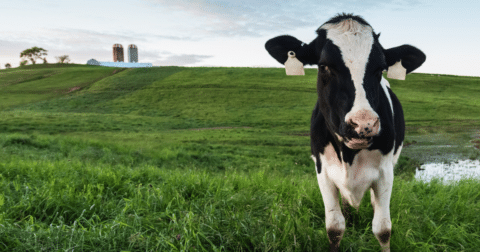Solutions
Miami Farmers Market Helps Fight Climate Pollution With Affordable Produce
Climate•6 min read
Reported
A new report suggests the government might be funding the wrong solution.


Words by Marlena Williams
Dairy digesters, also known as anaerobic digesters, are an emerging and rapidly developing field of technology touted by some as a cost-effective solution to the massive amount of methane produced on industrial farms. Methane is a potent greenhouse gas responsible for about 30 percent of global warming since pre-industrial times — and animal agriculture accounts for more than one-third of U.S methane emissions. Dairy digesters are essentially oxygen-free systems that break down organic material like manure and turn methane into “biogas,” which can then be used to generate electricity or processed into transportation fuel.
But state and dairy industry officials may have significantly overstated the benefits and cost-effectiveness of California’s methane digester program, according to a new report from the Center for Food Safety. The California Department of Food and Agriculture has heralded the state’s Dairy Digester Research and Development Program (DDRDP) as one of the most cost-effective emissions reductions programs in the state, only costing about $9 for every ton of carbon dioxide equivalent abated.
Unfortunately, this number may ignore several other major forms of funding that have flowed to dairy digester projects from both state and federal sources. When factoring in the additional public funding many of these projects have received since 2014, as well as market incentives, the real cost is up to 17-times more than what state and industry officials have publicly claimed.
The United States and more than 150 other countries have signed onto the Global Methane Pledge, with the goal of reducing methane emissions by 30 percent from 2020 levels by 2030. Anaerobic digesters have formed a key element of the Biden administration’s methane reduction plan, and the Inflation Reduction Act funneled billions of dollars into programs and other incentive structures that support the production of biogas.
The methane problem is especially acute in California, which leads the nation in dairy production. California, like many states throughout the country, uses a dangerous manure storage technique in which animal waste is flushed from confinement areas into vast, open-air cesspools known as “lagoons.” As the organic material in these ponds breaks down, methane is produced and released into the air. According to the EPA, California is one of the highest emitters of methane in the nation, both from manure management and enteric fermentation (methane released from the digestive tracts of cattle).
To address this problem, California has been rapidly implementing policies to reach its goal of reducing methane emissions to 40 percent below 2013 levels by 2030. One of the primary ways the state hopes to achieve this goal is by investing in anaerobic digesters. The Dairy Digester Research and Development (DDRD) program, which is run by the California Department of Food and Agriculture (CDFA), started in 2014 to provide funding to digester projects throughout the state.
Since its inception, the DDRD program has provided an estimated $195 million in funding to digester projects in California. According to the Center for Food Safety, of the 159 digesters planned or currently operating in the state, 131 have received funding from DDRD. The program estimates that it will result in an abatement of approximately 21 million metric tons of Co2e over the coming 10-year period.
The CDFA says the DDRD program only costs about $9 for every ton of Co2e abated, making it the second-most cost-effective program funded by cap-and-trade in the state. However, this number may ignore other sources of funding and misrepresent the true costs of the state’s massive investments in dairy digesters.
Producers looking to implement dairy digesters into their farms receive funding and support from more than just the DDRD. In fact, many producers receive funding from multiple funding streams at once, several of which were not factored into the state’s analysis.
In addition to the DDRD, producers can receive direct support payments in the forms of grants and funding from a variety of other state and federal programs, as well as market incentives whereby producers receive funding for participation in low carbon, renewable or cap-and-trade government initiatives.
When accounting for these additional sources of revenue, the true cost of the dairy digester program could be closer to about $28 per ton of Co2e abated, and could even cost up to $159 per ton, taking into account the market incentives that help keep digester projects feasible.
Several other sources of funding were not factored into the Center for Food Safety’s calculations. This includes funding from the USDA’s Renewable Energy for America Program, which provides loans and grants to rural businesses looking to transition to more energy efficient systems, and settlement funds from the 2015 Aliso Canyon natural gas leak, when 109,000 metric tons of methane were released into the atmosphere, forcing local residents from their homes.
If these additional funding sources were factored in, the cost of the dairy digester program could be much higher.
While proponents see dairy digesters as a cost-effective means to produce renewable energy and lessen the climate impact of industrial farms, critics say the benefits of digesters are inflated and their environmental and social costs obscured.
“Manure biogas will further entrench inherently unsustainable and unjust systems of industrial animal agriculture and fossil fuel energy for decades to come, all for methane reduction benefits that have been significantly overstated by the U.S government, are inadequately tracked, and are insufficient to meet climate targets” Friends of the Earth says in their report, coauthored by Socially Responsible Agriculture Project.
Though digesters may help reduce methane emissions, they pose a host of other public health and environmental concerns that are not reflected in California’s optimistic statistics, including biodiversity loss and increased ammonia emissions. Transporting biogas will also involve piping or trucking hundreds of tons of manure from CAFOs on a frequent basis, increasing traffic and risking major leaks, explosions or spills in vulnerable local communities, as has happened in Michigan, Wisconsin and North Carolina.
Dairy digesters are only practicable on the largest concentrated animal feeding operations, or CAFOs, which tend to be far more polluting than the smaller operations that either cannot afford digesters, or don’t produce enough manure to effectively utilize them.
“The largest and most polluting CAFOs are in the best position to capture the benefits…of producing manure biogas, while pasture-based and integrated small-scale livestock producers, whose manure methane emissions are significantly lower, are completely excluded,” writes Friends of the Earth and Socially Responsible Agriculture Project in their report.
Critics warn of three perverse incentives insidiously baked into the biogas system. First, instead of implementing manure management systems that produce less methane, mega-dairies with digesters may continue to utilize dangerous and toxic manure management systems, such as waste lagoons, in order to produce as much methane for their digesters as possible. These manure management practices have already devastated the marginalized rural communities forced to live near CAFOs.
In addition to the horrible stench produced by factory farms, the predominantly Black and rural communities who live near them also face increased risks of respiratory, cardiovascular and other serious health issues. They also face the constant threat of water, air and soil pollution, leading many advocates to call waste lagoons a pressing environmental justice issue.
Producers may also aim to increase their herd sizes in order to maximize manure production. Friends of the Earth and SRAP found that herd sizes at facilities with digesters grew 3.7 percent year-over-year compared to those without them, meaning more and more animals could spend their lives in dangerous and inhumane conditions, even as the public signals increasing opposition to factory farms.
Finally, dairy digesters could lead to increased consolidation of industrial animal agriculture in a sector already dominated by a handful of corporate entities, which could in turn distort the market, reduce competition, drive-up costs and hurt workers and small-scale farmers.
Dairy digesters are not the only way to reduce the outsized environmental impact of factory farming. Evidence from a study conducted by Friends of the Earth suggests that reducing herd sizes by 20 percent, and implementing alternative manure management practices, could result in more than half of the methane reductions needed to meet the Global Methane Pledge by 2030 — more than what dairy digesters could achieve on their own. However, larger farms with at least 1,000 cows tend to be more profitable than smaller operations, with lower production costs and higher net returns. What’s more, farms that opt for other, more climate-friendly methods will not reap the financial benefits of the growing, state-and-federally-funded biogas infrastructure.
Governments also need to improve the tracking and monitoring systems for the dairy digesters projects already in place. To receive DDRP funding in California, for example, a project only needs to calculate its estimated emissions savings and self-report data every five years.
Furthermore, there is no comprehensive list of dairy digester projects currently operating or under construction nationwide. Increased transparency and improved emissions tracking and monitoring could help the public to better understand the true costs and benefits of anaerobic digesters.
While improved tracking and industry analysis is necessary before anyone can call dairy digesters a total bust, it is important to be mindful of government and industry reports that overstate the benefits of biogas and underplay its potential pitfalls. Whether the cost of anaerobic digesters in California is $9 per ton or $159 per ton, the true cost of biogas may be felt most acutely by rural communities, farm animals and the environment.
This piece has been updated to reflect that Socially Responsible Agriculture Project co-authored the report with Friends of the Earth.